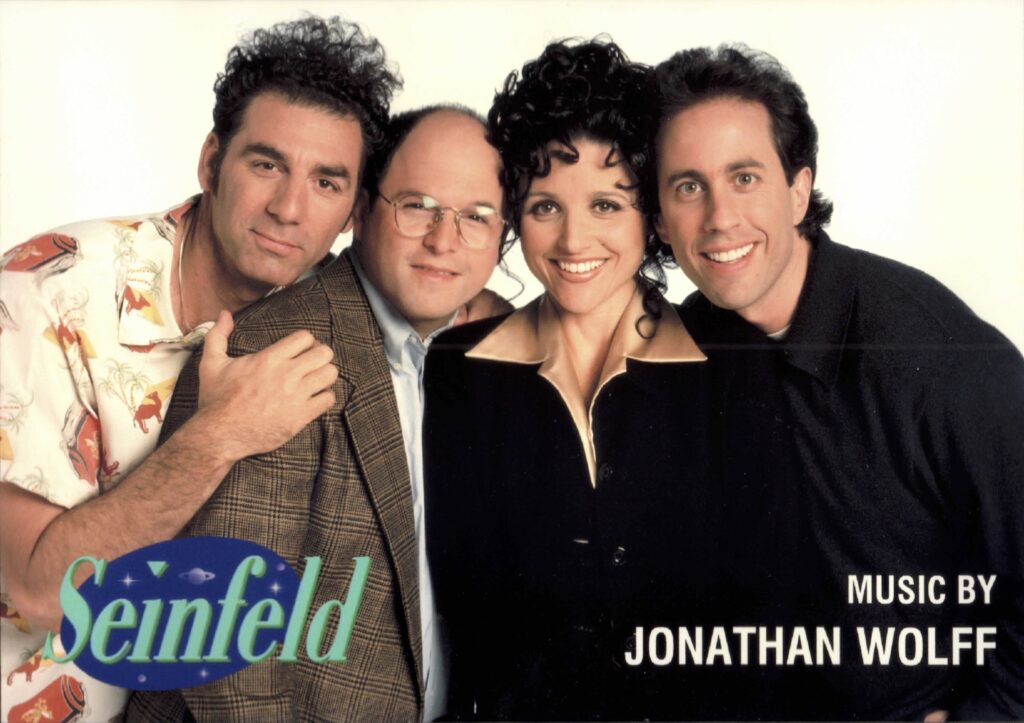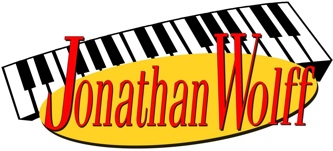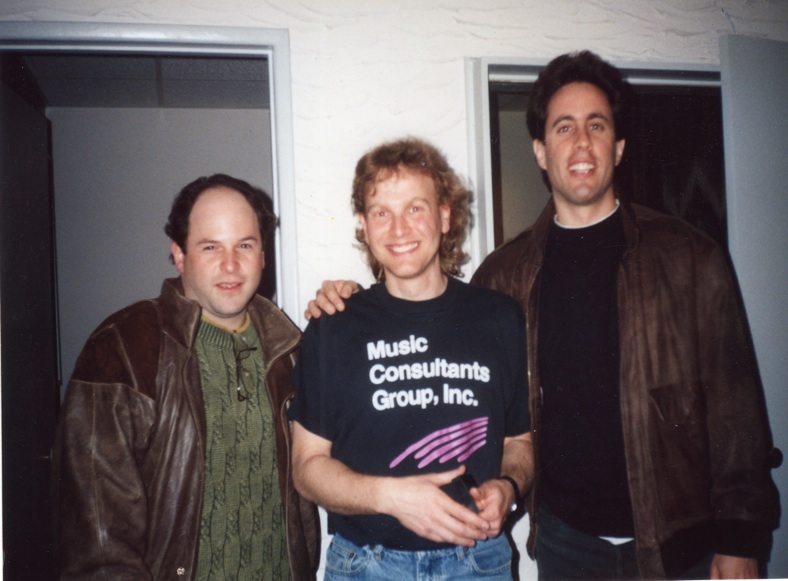Yada Yada Yada

Most of us know the show Seinfeld. Some of us grew up with it. Some of us discovered it long after the last episode aired on May 14, 1998. Regardless of where we stand on the show, if you grew up in the US, you at least know the name. And if, by chance, you don’t know the name I guarantee you are familiar with at least a few of the isms that came out of it to become part of our pop culture history.
Case in point…..the title of this section.
Believe it or not, the show was not an overnight success. In fact, the network originally only ordered 4 episodes after the pilot and it didn’t hold a time slot until Season 4 or 5.
It was a show about nothing. And yet it was about everything!
A Sound Design Problem

I got to sit down with a very important member of that team, Jonathan Wolff, Seinfeld composer and theme writer extraordinaire. I interviewed him for Episode 38 and 39 of the Sound In Marketing Podcast. Jonathan, having written that iconic theme song, will forever go down in history. It was different from 80’s theme songs of the time. Which was a perfect fit for the show that no one really knew what to do with in the first place.
But Jonathan wasn’t hired from the beginning. He came in after the pilot as the original composer hired wasn’t quite “hitting the mark”. Jonathan was told that it was “a sound design problem.”
A Show About Nothing
Jerry Seinfeld and Larry David had a show that was to play off of the comedy stylings of Jerry Seinfeld. The show would open with one of his many monologues. It would then play off the monologue within the episode and conclude with an ending monologue to bring it all home.

The theme needed to be catchy and recognizable but not “get in the way” of Jerry’s stand up material.
Jonathan Wolff
Jonathan, already a seasoned TV composer having written for over 75 primetime shows including Married With Children and Who’s the Boss, took on this project as a favor to his friend George Wallace. Seinfeld only had 4 episodes bought by the network and for some reason Jonathan took a chance.
The chance turned into an opportunity of a lifetime.
This was a chance to create something different.
Getting “Out Of The Pile”
Anyone who’s spent any time in Hollywood knows that creators can be seen as a dime a dozen. The 80’s was no different and even for Jonathan, a seasoned writer, he was constantly being passed up for jobs by other composers either more qualified or simply because they were the “flavor of the month”.
In order to stand out, you had to be or do something different.
Jonathan Wolff
Jonathan wanted to “get out of the pile”.
Sampling technology was in its infancy and Jonathan wanted to be on the forefront. With this opportunity that Seinfeld him he was able to experiment. He could use and do things that people weren’t experimenting with mainstream. There was virtually no audience and little attention given to it by the network giving all involved the ability to have a little fun.
Jonathan was able to get out of that pile.
Something Different
As every episode had a different monologue, the music was slightly different each week. The theme had to be adapted and manipulated week by week to stay in time and in correct reference to each script and to Jerry’s lines and delivery. The bass line he created was very simplistic allowing the rhythm to be easily modified and manipulated to do just that.

Slap bass, in the late 80’s, was not a solo instrument. Generally, it was buried in funk music. Jonathan decided to spotlight it making the bass the cornerstone to the Seinfeld sonic brand. He built the music around the quirky energy of New York City and Jerry Seinfeld’s comedy. The organic nature of the city stylings helped to blend with Jerry’s speaking voice perfectly.
No Soup For You!
There was very little push back on the music that Jonathan created. People generally liked it and let him be creative and explore. Larry and Jerry were sold from the beginning.
However, in renegotiations for a Season Two, the network had “some notes”. They didn’t like the music (they said it was annoying) and had all sorts of notes for casting and script and story (yada yada yada). Larry David was not happy with this. When the Seinfeld composer said “no problem” to readjusting the theme, Larry’s eyes lit up, said “don’t you dare” (in so many words). Jonathan was then kicked out of the meeting. Jonathan is fairly confident none of the notes that day were addressed and, obviously, the music remained the same.
Larry David was able to make the show how he wanted and Jonathan was able to write the music how he wanted.
“It was a Camelot era of being able to have certain freedoms.”
Jonathan Wolff
Seinfeld Composer Extraordinaire!
Around Season 4 or 5, Seinfeld started to gain a following (and a time slot). Now there were all these backlogged episodes that no one or very few people had ever seen which secured their syndication package. This also made Jonathan Wolff “flavor of the month” for about 10 years.
Sound and Music Matters
“Theme music is a first impression sales tool to help pitch a new show to an audience.”
Jonathan Wolff
Doesn’t that sound like something a brand and company would want? A way to hook a customer before they hold a tangible object. To intrigue before any product is even seen or experienced.
Take the Fresh Prince of Bel Air Theme Song. It had huge entertainment value but also was used as an informational tool to prepare the audience for what was to come. It literally told the whole story of the show in under 2 minutes and heightened anticipation to watch more.
The Cheers theme song welcomes the audience into the bar. It makes them feel at home and gives a sense of belonging as the vocalist tells the story of how hard the day to day is. Ultimately the audience decides to sit back and join their “friends” for a beer.
People hold the warm fuzzies for these themes. It keeps the shows alive and enduring in memory. It creates conversation to re-explore the show years later and also to invite new audiences in to experience it all over again.
Sound Adds Value
No one can deny that sound and music in entertainment and pop culture hold value and power to consumer buying tendencies. Seinfeld composer, Jonathan Wolff learned this first hand. So why are we still ignoring that power in our marketing strategy?
The theme comes first. It matters. It adds value. A music logo comes first. It matters. It adds value. Music and sound matter and should be considered in any good marketing strategy. It shouldn’t just belong in the movies.
Related Articles on Sonic Branding
For more articles on Sonic Branding, check out:
Sonic Branding in a Sound On World
How Dove Succeeded Creating a Massive Sensorial Experience
The Difference Between Jingles and Sonic Logos
Ready to Create?
Dreamr Productions would love to help. Contact us today for more information.


